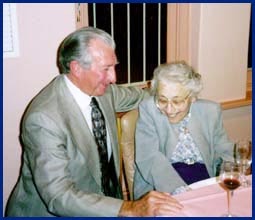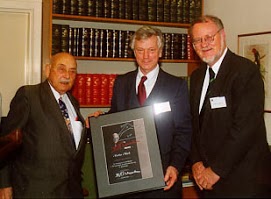The 1999 BH Neumann Awardees were Keith Hamann, Howard Reeves and Martin Ward. They were presented with their awards at separate ceremonies and their citations follow.

A BH Neumann Award has been awarded to Tasmanian Mathematics Educator Howard Reeves.
Reeves (pictured above with Professor Neumann and wife Judith after receiving the Award in Hobart at the Blue Eye seafood restaurant on Thursday 19 August 1999), currently the Professional Curriculum Officer (Mathematics) in the Tasmanian Department of Education, has provided strong service to Mathematics Education in Tasmania and nationally since he first obtained a Tasmanian Teachers Certificate in 1971.
The Award, made by the Australian Mathematics Trust, is for Howard’s “Significant Contribution to the Enrichment of Mathematics Learning in Australia”. The Trust, a non-profit organisation which administers contests, enrichment activities and Australia’s role in the International Mathematical Olympiad, makes up to three of these Awards annually. They are named in honour of Professor BH Neumann AC, Foundation Professor of Mathematics in the Research School of Mathematical and Physical Sciences at the Australian National University and founder of the Australian Association of Mathematics Teachers. Professor Neumann, who turns 90 this year, travelled to Hobart to personally bestow the Award on Howard Reeves.
Born at Wynyard, Howard graduated in 1972 with a BSc and Dip Ed from the University of Tasmania and had teaching positions up to the level of Senior Mathematics Master at New Norfolk High School, Hobart Matriculation College and Reece High School, before taking up his present position, in which he is able to provide resources to mathematics teachers all over Tasmania.
Howard has provided a significant contribution to the Mathematical Association of Tasmania, of which he was President and to the Australian Association of Mathematics Teachers, of which he served a two-year term as President in 1992 and 1993 and member of Council for many years.
He has been heavily involved in both Tasmanian and National Curriculum activities, having been involved in drafting the national statement on Mathematics for Australian Schools, and worked on Tasmanian projects for K-8 Mathematics Guidelines, Planning and Teaching for Numeracy in Years 7 to 9 and many others. He has written or co-authored a number of National and Tasmanian papers on mathematics teaching and the curriculum.
Howard was a member of the Australian Mathematical Sciences Council from 1991 to 1993, the Australian Mathematical Olympiad Committee from 1988 to 1998, the Advisory Committee of the Australian Mathematics Trust since 1992, and has been Tasmanian Director of the Australian Mathematics Competition for the Westpac Awards since 1986.
He was also awarded the Australian College of Education Tasmania Award in 1996 and was conferred Life Membership of the Mathematical Association of Tasmania in 1998.
Peter Taylor
19 August 1999


Keith with former winner of the BH Neumann Award Marta Sved, at the function.
The Board of the Australian Mathematics Trust has announced the awarding of a BH Neumann Award for South Australian Mathematics Educator Keith Hamann.
This award, named in honour of Professor BH Neumann, the father of Australian Mathematics, was presented by Professor Neumann at a function at the Lenzerheide restaurant, Hawthorn on the evening of Thursday 10 June 1999.
Keith has a long and distinguished career which has impacted on the quality of mathematics teaching both nationally and within South Australia.
Keith served two terms as South Australian Director of the Australian Mathematical Olympiad Committee. He was the Foundation State Director, serving from 1980 to 1982 and is the current Director, this term having commenced in 1991. So he has spent almost 12 years coordinating extension activities for the most talented students in the state. During this time a number of South Australian students have been selected in the Australian team to participate at the International Mathematical Olympiad.
One of Keith’s major achievements was to co-author the text for the Polya Enrichment Program of the Mathematics Challenge for Young Australians. This constitutes a significant part of this Enrichment Program, which thousands of students are using each year to extend their mathematical knowledge and skills.
Keith had a long career with the South Australian Department of Education, dating back to 1960 when he became a Special Senior Master in Mathematics and Physics. From 1967 to 1970 he was the Mathematics Consultant in the Department. From 1971 to 1985 he was first Inspector and later Principal Education Officer in Mathematics and Physics.
In 1985 and 1986 he also served a term with the independent school system, being Head of Mathematics at Wilderness College.
Keith has served the professional organisations for mathematics teachers with distinction. He first served as Secretary of the Mathematical Association of South Australia (MASA) from 1964 to 1968, and then President from 1969 to 1971. He has since served a further term as President in 1995 and 1996 and commenced a term as Vice President in 1998 (a post he still holds).
He has also served two terms on the Council of the Australian Association of Mathematics Teachers (AAMT), these being from 1966 to 1971 and from 1994 to 1996. He recently chaired the organising committee of the highly successful AAMT biennial conference in Adelaide in January 1999.
In addition to the above activities, Keith has organised many extra enrichment activities for students. The sort of activities he runs are monthly after school workshops, enrichment mathematics days, Saturday morning workshops, three-day workshops and many other miscellaneous enrichment sessions, which he has attended when organised by schools and other organisations.
The Mathematics days are full-day programs held at St Peters and Seymour College (about 3 or 4 per year) for high achievers from years 8 to 10 in school mathematics competitions. The Saturday morning workshops are for senior “graduates” from the enrichment days. At these days problems sets are sent two weeks before the workshops and Keith receives great support from mathematicians of the University of Adelaide such as Alexei Filinkov, Paul Scott, John van der Hoek and Jane Pitman. The three-day workshops are for invited year 8 to 10 students who achieve High Distinctions in the Australian Mathematics Competition.
To conclude, Keith Hamann is a most worthy recipient of the BH Neumann Award.
Peter Taylor
10 June 1999

Professor Neumann, Martin Ward and ANU Vice-Chancellor, Professor Deane Terrell at the Award ceremony at the ANU on the evening of Tuesday 29 June 1999.
This award, named in honour of Professor BH Neumann, the father of Australian Mathematics, was presented by Professor Neumann at a function at the ANU on the evening of Tuesday 29 June 1999.
With respect to Australian Mathematics Trust activities, Martin Ward mostly comes under notice as a problem creator for the Australian Mathematics Competition Problems Committee. Martin has been a member of this committee over a number of years, including the earliest years 20 years ago. He is responsible for many of the most challenging questions which have appeared in the paper, some of a geometrical nature (including 3 dimensions), others of a graph theory nature, and others algebraic. Whatever Martin’s questions are distinctive for their freshness and the intellectual (but always apparently achievable) challenge which they provide.
Martin almost became a chemist, and in fact first completed a chemistry degree at the University of Melbourne. He then decided that he did not wish to spend his life in a laboratory.
He then started his experience with the ANU, an experience in which he claims to have been the first resident ever of University House, attended the Canberra University College, completing an ANU Honours degree in mathematics in 1963, and possibly completing only the second Maths PhD at the ANU in 1966, only just after Martin Dunwoody.
His work was in Algebra and his supervisor was Hanna Neumann, although she was not here at the beginning and Bernhard was his interim supervisor. He commenced as a Lecturer in Mathematics in 1966 and was promoted to Senior Lecturer in 1970.
While at the ANU Martin, often with Neville Smyth, has been involved with many innovative teaching programs. I recall that they worked to introduce the Keller plan back in the 70s, to enable students to undergo self-paced learning. I do not think that this still operates because it has depended heavily on tutor manpower, but it was quite revolutionary at the time.
Martin is probably best known nationally, and in fact internationally, for his work as co-developer with Neville of ANU GRAPH, one of the best graphical teaching programs on the market. Whereas this has been developed over many years it is still being actively maintained, with a new version for imminent release.
Martin has been heavily involved by his department in developing curriculum and teaching methods for the first year courses. Technology is often a component of the methods he develops.
He has taken a particular interest in the ANU’s Distinguished Scholar Program, where he works with a small group of students in his office on a blackboard each year teaching topology. This has proved a particularly effective method with the best students.
Finally, Martin’s role with music should be acknowledged. He has been very involved with playing, composing and the technicalities of computer-based music. This is relevant because mathematics and music touch each other in so many ways. He gives a lecture at ANU Open Days on mathematics and music, but the only thing we have not yet seen from him is an AMC question based on music. This is his next mission.
Peter Taylor
29 June 1999
